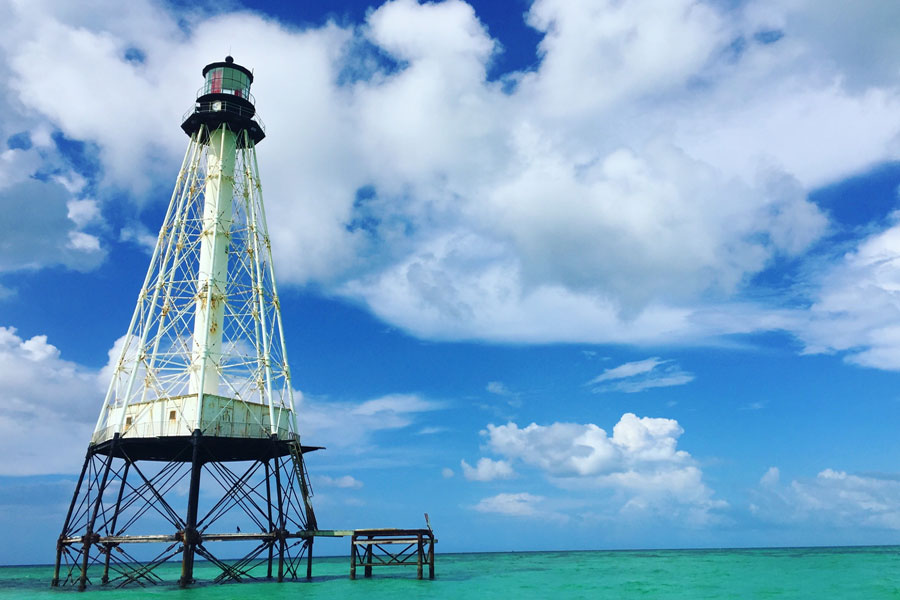Alligator Reef Light House

Situated about four nautical miles off the coast of Islamorada, Alligator Reef Lighthouse stands as a testament to maritime history and natural beauty in the Florida Keys. Built in 1873, this offshore lighthouse is named after the USS Alligator, a naval schooner that ran aground on the reef in 1822 while protecting merchant ships from pirates. Today, the lighthouse and its surrounding reef are popular destinations for snorkeling, diving, and fishing, offering visitors a glimpse into the vibrant underwater world of the Keys.
Things to Do at Alligator Reef Lighthouse
- Snorkeling and Diving
The waters surrounding Alligator Reef Lighthouse are crystal-clear and teeming with marine life:- Explore vibrant coral formations that make up part of the Florida Keys National Marine Sanctuary.
- Swim alongside tropical fish, sea turtles, rays, and occasionally nurse sharks in the shallow waters (about 8-20 feet deep).
- Discover shipwreck remnants and historical artifacts scattered around the reef.
- Wildlife Watching
The area is rich in biodiversity, making it perfect for marine enthusiasts:- Spot schools of parrotfish, angelfish, and sergeant majors darting among the coral.
- Look for larger species such as barracudas, tarpon, and even reef sharks.
- Birdwatchers can also observe seabirds like frigatebirds and cormorants perched near the lighthouse structure.
- Kayaking and Paddleboarding
Adventure-seekers can paddle out to the reef for a unique perspective:- Kayak or paddleboard through calm waters while enjoying views of the lighthouse and surrounding ocean.
- Many local outfitters in Islamorada offer rentals and guided tours to the reef.
- Photography
The lighthouse’s iron skeleton structure and turquoise waters create stunning backdrops:- Capture the lighthouse at sunrise or sunset for dramatic and colorful photos.
- Underwater photography enthusiasts can snap incredible shots of the marine life and coral formations.
- Fishing
The reef is a prime fishing spot in the Florida Keys:- Catch species like snapper, grouper, and pelagic fish in the surrounding waters.
- Charter a fishing boat for expert guidance and access to deeper waters near the reef.
Historical Significance
The Alligator Reef Lighthouse has a fascinating history tied to the Florida Keys:
- Named after the USS Alligator, a naval schooner that was deliberately sunk after running aground on the reef in 1822.
- The lighthouse was built to prevent shipwrecks on the dangerous coral reef, which was notorious for stranding vessels.
- Its iron frame and screw-pile foundation were innovative engineering feats for the time, allowing it to withstand harsh ocean conditions.
Preservation and Conservation
As part of the Florida Keys National Marine Sanctuary, Alligator Reef is protected to preserve its ecological and historical value:
- Fishing, snorkeling, and diving are permitted but regulated to ensure minimal impact on the reef.
- Visitors are encouraged to use mooring buoys rather than anchoring to protect the delicate coral.
- Awareness programs educate visitors about the importance of marine conservation and sustainable tourism.
Amenities & Facilities
Since Alligator Reef Lighthouse is located offshore, there are no on-site facilities, but nearby Islamorada offers plenty of resources:
- Boat Rentals and Charters: Available from local marinas for transportation to the reef.
- Snorkel and Dive Gear Rentals: Provided by outfitters in Islamorada.
- Guided Tours: Eco-tours and snorkeling excursions are popular ways to experience the lighthouse and reef.
Accessibility
The lighthouse and reef are accessible only by boat:
- Chartered Tours: Many companies in Islamorada offer snorkeling and diving tours to the reef.
- Private Boats: Visitors with access to private boats can navigate to the lighthouse using GPS coordinates.
- Kayaks and Paddleboards: For adventurous travelers, paddling out to the reef is a rewarding option, though it requires good weather conditions.
Tips for the Lighthouse
- Use Reef-Safe Sunscreen: Protect the marine environment by avoiding harmful chemicals.
- Respect Marine Life: Avoid touching corals or disturbing wildlife during your visit.
- Pack Essentials: Bring plenty of water, snacks, and sun protection for your excursion.
- Check Weather Conditions: Calm seas and clear skies provide the best snorkeling and boating experiences.
- Plan Ahead: Book charters or rentals in advance, especially during peak travel seasons.
Vicinity of the Lighthouse
Nearby Attractions
- Robbie’s of Islamorada: Feed tarpon, rent kayaks, or enjoy waterfront dining at this popular spot.
- Theater of the Sea: Interact with dolphins, sea lions, and other marine animals in this family-friendly park.
- Indian Key Historic State Park: Paddle to this nearby island for hiking and historical exploration.
- Lignumvitae Key Botanical State Park: Discover a preserved tropical hardwood hammock and learn about the area’s ecological history.
Why Visit Alligator Reef Lighthouse?
Alligator Reef Lighthouse combines history, adventure, and natural beauty in a way that few destinations can. Whether you’re snorkeling among vibrant coral reefs, kayaking through turquoise waters, or fishing in one of the Keys’ richest ecosystems, the lighthouse offers a truly unique experience. Its historical significance and ecological importance make it a must-visit spot for anyone exploring the Florida Keys, providing memories that will last a lifetime.
For more information visit: https://fla-keys.com/keysvoices/alligator-reef-lighthouse-shines-once-again/ 
